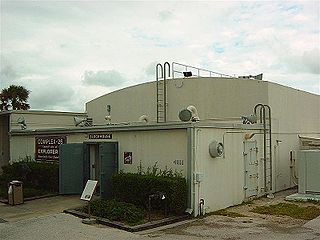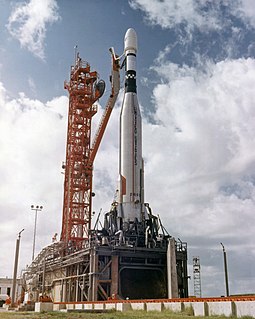
Cape Canaveral Air Force Station (CCAFS) is an installation of the United States Air Force Space Command's 45th Space Wing.

Launch Complex 2 (LC-2) is a deactivated US Air Force launch site on the eastern tip of Cape Canaveral, Florida at Cape Canaveral Air Force Station. It was constructed with launch complexes 1, 3, and 4, in the early 1950s, for the Snark missile program.

Cape CanaveralAir Force Station Launch Complex 34 (LC-34) is a launch site on Cape Canaveral, Florida. LC-34 and its companion LC-37 to the north were used by NASA from 1961 through 1968 to launch Saturn I and IB rockets as part of the Apollo program. It was the site of the Apollo 1 fire, which claimed the lives of astronauts Gus Grissom, Ed White, and Roger Chaffee on January 27, 1967.

Cape Canaveral Air Force Station Space Launch Complex 37 (SLC-37), previously Launch Complex 37 (LC-37), is a launch complex on Cape Canaveral, Florida. Construction began in 1959 and the site was accepted by NASA to support the Saturn I program in 1963. The complex consists of two launch pads. LC-37A has never been used, but LC-37B launched uncrewed Saturn I flights and was modified and launched Saturn IB flights, including the first (uncrewed) test of the Apollo Lunar Module in space. It was deactivated in 1972. In 2001 it was modified as the launch site for Delta IV, a launch system operated by United Launch Alliance.

Launch Complex 19 (LC-19) is a deactivated launch site on Cape Canaveral Air Force Station, Florida used by NASA to launch all of the Gemini manned spaceflights. It was also used by unmanned Titan I and Titan II missiles.

Cape Canaveral Air Force Station Space Launch Complex 41 (SLC-41), previously Launch Complex 41 (LC-41), is an active launch site at Cape Canaveral Air Force Station. The site is currently used by United Launch Alliance (ULA) for Atlas V launches. Previously, it had been used by the USAF for Titan III and Titan IV launches. The first launch of Vulcan is currently expected in April 2021.

Launch Complex 14 (LC-14) is a launch site at Cape Canaveral Air Force Station in Florida. LC-14 was used for various manned and unmanned Atlas launches, including the Friendship 7 flight aboard which John Glenn became the first American to orbit the Earth.

Launch Complex 5 (LC-5) was a launch site at Cape Canaveral Air Force Station, Florida used for various Redstone and Jupiter launches.

Launch Complex 36 (LC-36)—formerly known as Space Launch Complex 36 (SLC-36) from 1997 to 2010—is a launch complex at Cape Canaveral Air Force Station in Brevard County, Florida. It was used for Atlas launches by NASA and the US Air Force from 1962 until 2005.

Launch Complex 26 (LC-26) is a deactivated launch site at Cape Canaveral Air Force Station, Florida. LC-26 consisted of two pads, A and B. Pad A was used for the Jupiter-C and Juno I rockets, and was the launch site for Explorer 1, the United States' first satellite, in 1958. Pad B was used for Juno II. Jupiter IRBMs were launched from both pads.
Space Launch Complex 20 (SLC-20), previously designated Launch Complex 20 (LC-20), is a launch site at Cape Canaveral Air Force Station, Florida. SLC-20 is located at the northern terminus of ICBM Road, between Space Launch Complex 19 and Space Launch Complex 34.

The Air Force Space and Missile Museum is located at Launch Complex 26 at Cape Canaveral Air Force Station, Florida. It includes artifacts from the early American space program and includes an outdoor rocket garden displaying rockets, missiles and space-related equipment chronicling the US Air Force.

Launch Complex 11 (LC-11) at Cape Canaveral Air Force Station, Florida, is a launch complex used by Atlas missiles between 1958 and 1964. It is the southernmost of the launch pads known as Missile Row. When it was built, it, along with complexes 12, 13 and 14, featured a more robust design than many contemporary pads, due to the greater power of the Atlas compared to other rockets of the time. It was larger, and featured a concrete launch pedestal that was 6 metres (20 ft) tall and a reinforced blockhouse. The rockets were delivered to the launch pad by a ramp on the southwest side of the launch pedestal.

Launch Complex 13 (LC-13) was a launch complex at Cape Canaveral Air Force Station, the third-most southerly of the original launch complexes known as Missile Row, lying between LC-12 and LC-14. The LC-13 site is currently leased by SpaceX and has been renovated for use as Landing Zone 1 and Landing Zone 2, their east coast landing location for returning Falcon 9 and Falcon Heavy launch vehicle booster stages.
Launch Complex 15 (LC-15) at Cape Canaveral Air Force Station, Florida is a deactivated launch complex used by LGM-25 Titan missiles between 1959 and 1964. It was originally built for conducting test flights of the Titan I, which made its maiden flight from LC-15 on 6 February 1959. LC-15 is the southernmost of the four original Titan launch complexes on Missile Row.

Launch Complex 31 (LC-31) is a former launch complex at Cape Canaveral Air Force Station, Florida.
Launch Complex 22 (LC-22) at Cape Canaveral Air Force Station, Florida is a launch complex that was used for horizontal launches of cruise missiles between 1957 and 1960. It consisted of two launch rails, from which XSM-73 Bull Goose and MGM-13 Mace missiles were tested. Unlike the other Mace launch site, Launch Complex 21, no concrete structure was built to enclose the launch rails when it was converted to launch the Mace in 1959. This earned the pad the nickname of "the softsite".
Launch Complex 32 (LC-32) is a former launch complex at Cape Canaveral Air Force Station, Florida.
Launch Complex 25 (LC-25) was a four-pad launch site at Cape Canaveral Air Force Station, Florida built for test flights of the US Navy's submarine-launched ballistic missiles Polaris, Poseidon and Trident from 1958–1979.

Cape Canaveral Air Force Station Launch Complex 47 is a launch pad for sounding rockets located at the north end of Cape Canaveral Air Force Station, Florida. It is the smallest launch complex used in the air force station. The complex features a small blockhouse a few yards from the pad, containing vehicle-specific hardware. Between 1984 and 2008, 531 sounding rockets were launched from pad 47. All weather rocket operations were relocated here from Launch Complex 43 in 1984 in order to make room for the construction of Launch Complex 46.
















